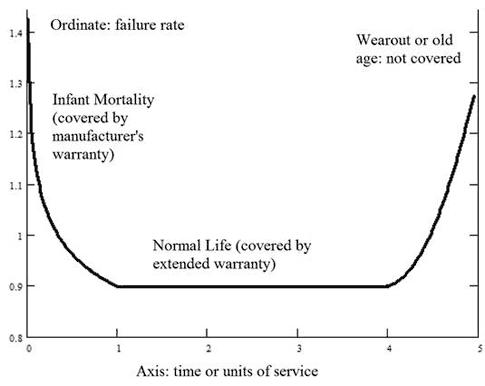Many appliance, big box, and other stores recommend the purchase of extended warranties to go with consumer electronics. They are available for automobiles as well, but they are rarely if ever cost effective. The bathtub curve (figure 1), a model for failure or hazard rates in reliability engineering, explains why.

Figure 1: Bathtub curve
A product is usually most vulnerable to failure when it comes out of the factory because of defects in manufacture. These defects are not sufficiently severe to fail outgoing tests or inspections but they make themselves known shortly after the product is placed into service. This is especially true of many semiconductor and other electronic products; a computer that is six months old is often less likely to fail than a brand new one.
…
Comments
Messages such as this need to be broadcast to a greater audience
The fact that extended service, extended warranty or other form of the same are offered in the product's normal life is exactly the reason these plan administrators exist. Their own actuaries calculate expected claims payments, reserve (future liability) in the active periods for these warranties. Not only do these companies know that the repair rates (excluding physical damage) for ALL products are exceedingly low in the normal life periods, buy that general consumer ignorance and fear will drive business and create hefty profits for the plan administrator and the sellers/retailers. With incidence of repairs low, the odds of using the plans are low. There is NO model that favors the consumer. In fact, one has much better odds at black jack tables in Vegas. If society was rational and made more decisions based on sound reasoning and research, extended warranties, and their companies, would not exist.
Consequently, In the retail environments, study after study confirms that pushing these plans creates negative customer relations. Within retail culture and within the stores, lack of execution from the behind the scenes extended service plan administrators actually exacerbates operational stress on store management and has a net negative impact on the customer experience. Retail executives tend to be blinded by the profit.
Add new comment